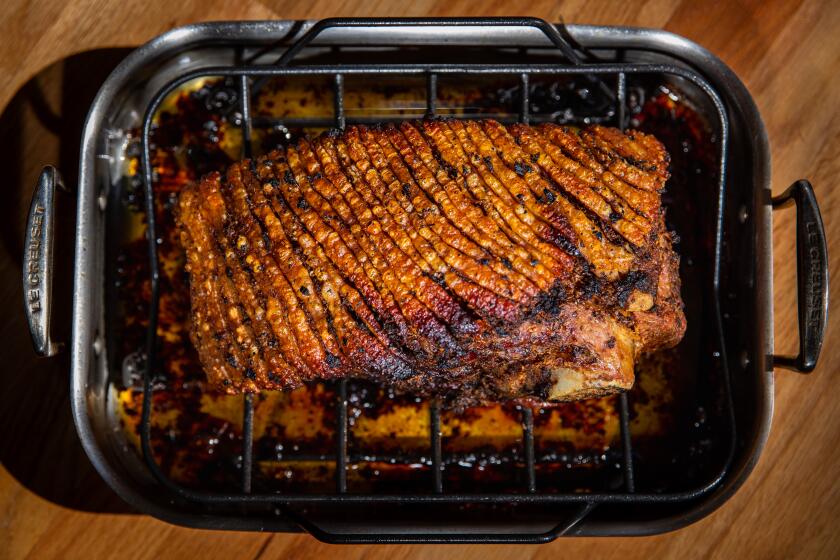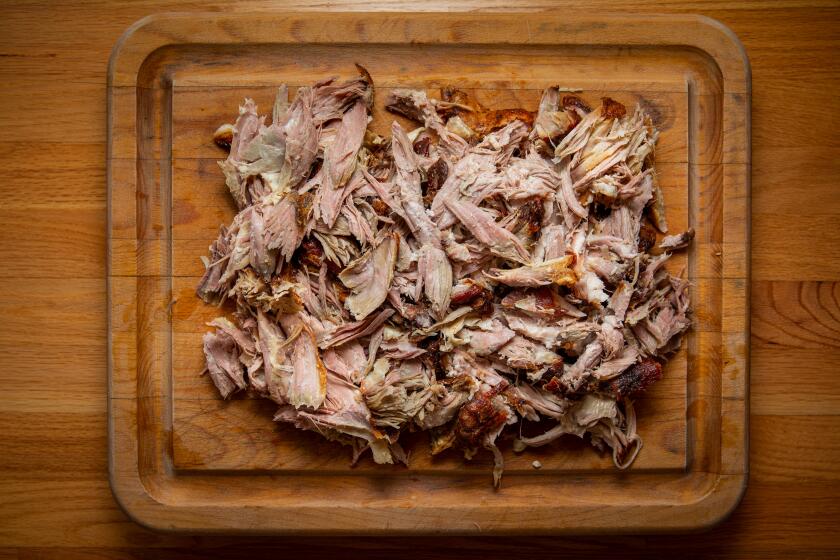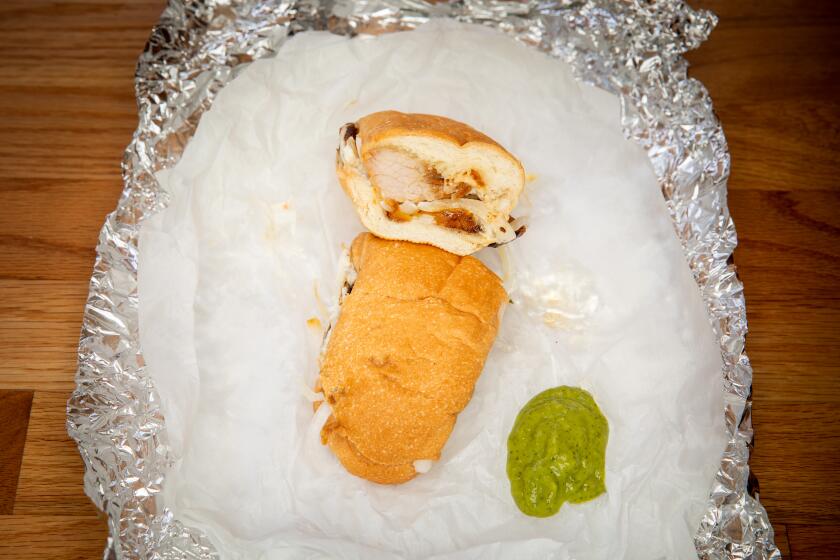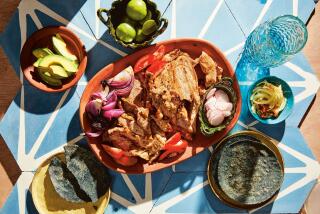A pork shoulder worth waiting for
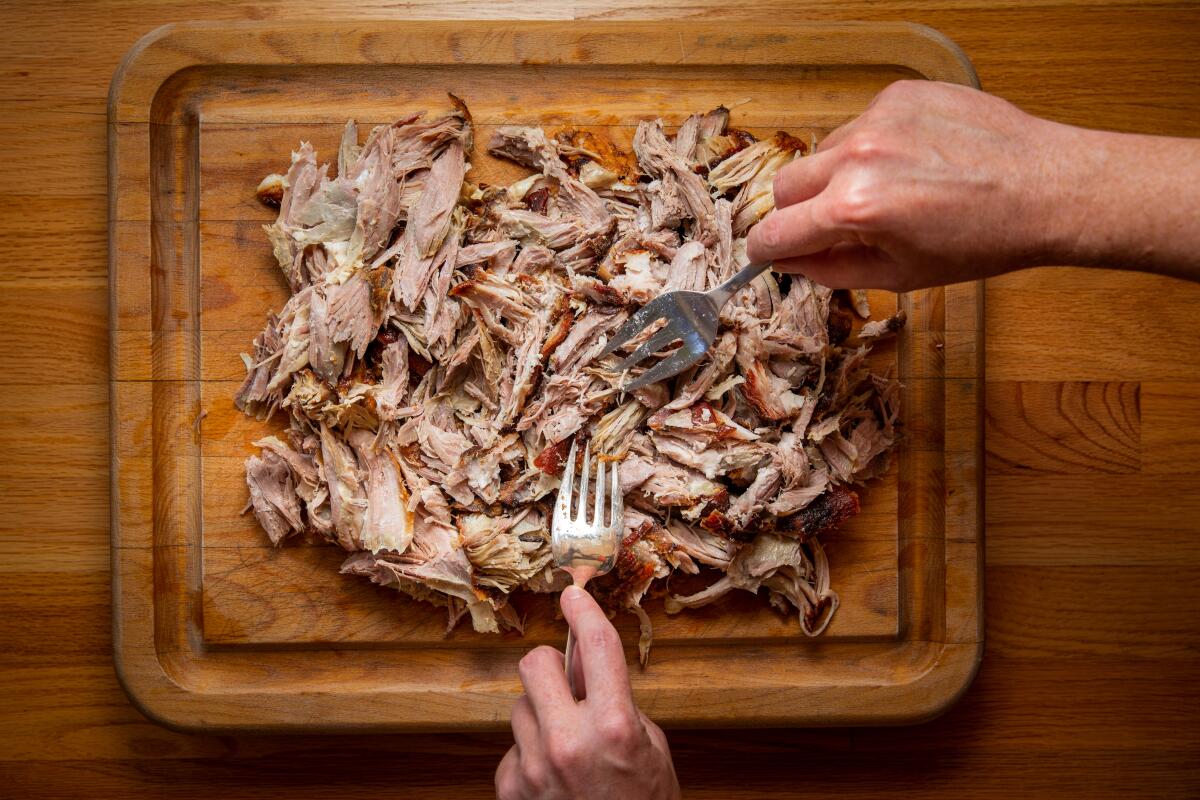
- Share via
For weeks, I had hyped a North Carolina-style barbecue dinner I planned to cook for friends. In the Tar Heel State, pigs are traditionally cooked whole, but I chose a bone-in pork shoulder because that’s all my friend’s outdoor grill could fit. I set the shoulder on a pan in the grill set at 250 degrees and left it to do its thing.
I returned four hours later and the shoulder looked glorious. After letting it rest for 30 minutes, I went to shred it with two forks. It barely budged, holding stiff like a rubber ball. As everyone sat at the table, awkwardly staring at the fried hush puppies, creamy coleslaw and baked beans that rounded out the meal, I was sweating in the kitchen, slicing the meat as thin as possible in a vain attempt to salvage it. After I brought it to the table, my congenial friends quietly ate the meat and offered up well-meaning praise, while I contemplated what they were actually thinking. My pulled pork nightmare had become reality.
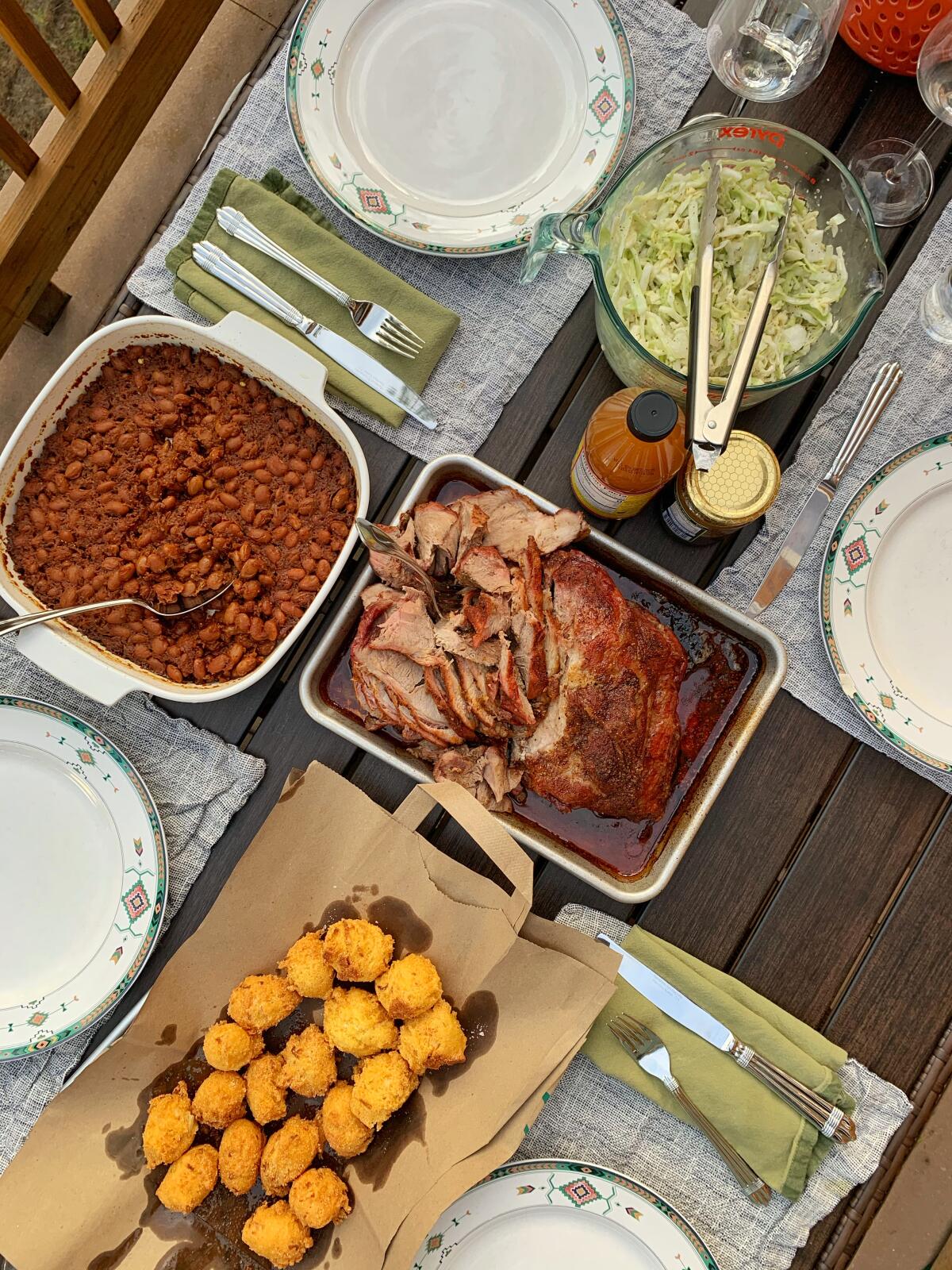
As someone adept at developing recipes for quick-cooking weeknight meals or party food for smaller groups using basic kitchen equipment, I had only ever cooked pork shoulders in the moist environment of a relatively fast oven braise. But leaving that same cut in the dry heat of a grill was another matter altogether. My experience had unwittingly given me a false sense of security around how long pork shoulders actually take to cook. Being raised around barbecue in the South, where pitmasters spend full nights tending to slowly smoked roasts, the unending hours seemed a part of barbecue folklore, not a necessity. My, how I was wrong.
I’m not a pitmaster, but I knew I wanted to get pitmaster-level tenderness from my home oven. I also wanted to understand why, throughout my years of cooking whole pork shoulders, some have been spoon-tender throughout, while some are stubbornly tough in parts. To get to that question, I first had to find answers to others from pork experts.
How do pigs’ breeds and diets affect the meat?
Farmer Oliver Woolley, who runs Peads & Barnetts Farm in northern San Diego County, explained how different breeds, and their diets, offer up surprisingly different cuts of pork.
“We raise Berkshires, so they have relatively more marbling in their meat than most other breeds,” says Woolley. “You have to treat it differently than supermarket pork shoulder because Berkshires have more collagen and fat. All that equals more flavor, but it means there’s also more that has to break down. It also makes a huge difference what the pig eats. Ours eat a wheat and seaweed diet, so the fat is waxy as opposed to soft, like in grocery store-types, where the feed might be soy or corn.”
Armed with that knowledge, it made sense that pork shoulders of unknown provenance purchased at your local grocery store most likely come from pigs bred to have softer meat. Olin Schneider, head butcher and general manager at McCall’s Meat & Fish Co. in Los Feliz, confirmed my theory.
“You have to realize that animals are not consistent,” says Schneider. “Sometimes we get shoulders [in the shop] with loose muscles, sometimes it’s tight and perfect. You have to ask yourself, ‘What did that muscle look like raw?’ If you have a pig that moves around a lot, you will have a tougher animal versus one that lays around all day.”
This explains why shoulders can yield inconsistent results.
So what are the keys to cooking consistently tender pork shoulder no matter the breed?
It turns out time and temperature reign. Daniel Castillo, pitmaster and co-owner of Heritage Barbecue in San Juan Capistrano, explains, “There’s no fast way to cook a pork shoulder. Two hundred degrees is the temp that connective tissue and intermuscular fat begin to change: Collagen turns into gelatin, and fat transforms from really rubbery to sticky. It’s the liquid gold that gives the meat that sticky mouthfeel you want, and you only get that with time.”
All those nights I witnessed barbecue cooks tending meat over hours that ran into the teens wasn’t for show after all. But now that I had uncovered the key to cooking pork shoulder, it was time to tackle how to pick the right cut for it.
What exactly is “pork shoulder” and what makes it unique?
The name “pork shoulder” glosses over the fact that there are actually two very different cuts using that appellation, and they require different approaches for success.
“When people come in asking for a ‘pork shoulder,’ typically they mean a ‘Boston butt,’ which is the upper portion that incorporates the shoulder blade,” says Schneider. “It has the fat and marbling that break down well in low-and-slow cooking and gives you something to shred. Whereas the ‘picnic,’ on the other hand, is most of the front arm, so you get more sinew. The muscles aren’t consistently sized like the ‘butt.’”
However, the “picnic” cut does offer one advantage that the “butt” does not.
“A lot of Puerto Rican families I know swear by ‘picnic’ for roast pork because if you want lots of crispy skin, it’s covered in it,” says Schneider. “But the meat itself is not as fatty as the ‘butt,’ so while there’s a lot of fat on the outside to protect it, there’s still a higher chance it can get overcooked and become dry.”
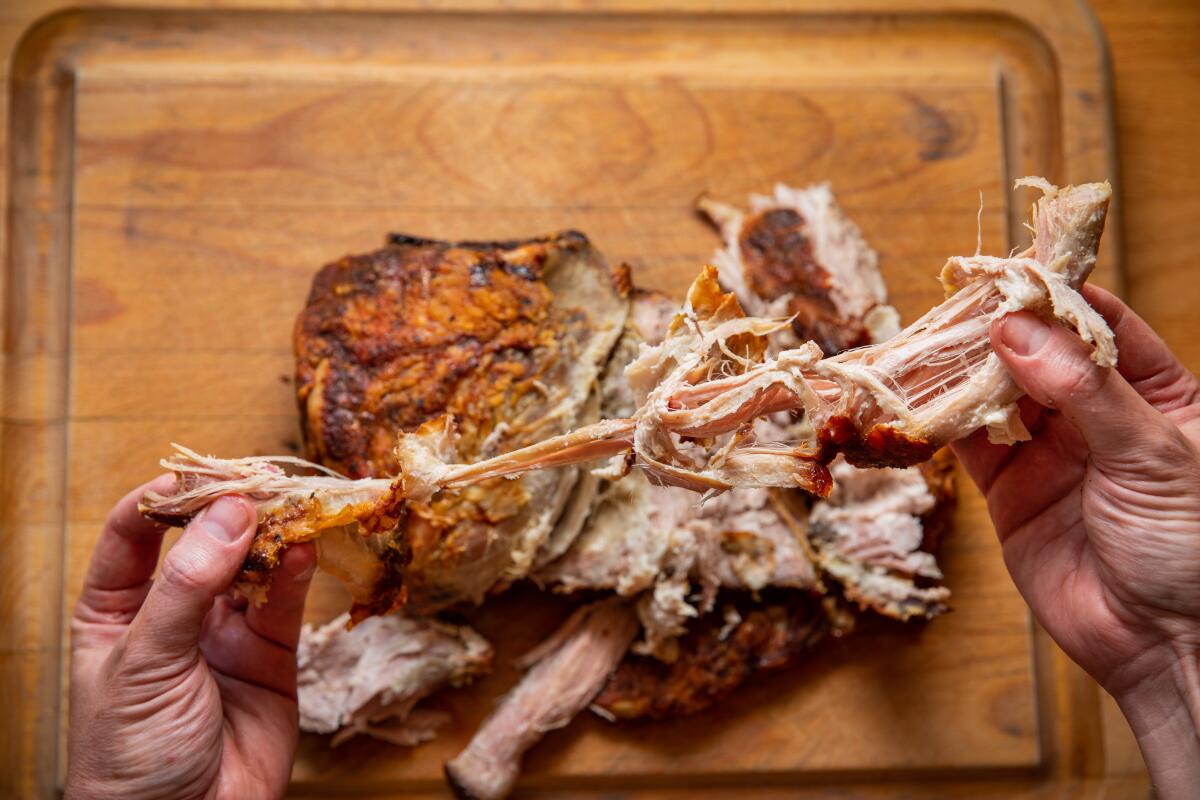
The “butt” or “Boston butt” — so named after the barrels, called butts, that used to store the cheap cut for transport in pre-Revolutionary War New England — offers that shredability that is the holy grail of cooking pork shoulder and something that barbecue pitmasters have long sought out to win competitions and loyal customers alike. Everyone I spoke to assured me that this is the people-pleasing cut you want for consistently tender pulled pork.
And while Castillo applies a carnitas method to the process of cooking pork shoulder at Heritage — “It’s hard to put ‘carnitas’ on the menu because that’s a specific thing, but that’s exactly what we’re making, a smoked carnitas” — he offers up the best way to get foolproof pulled pork in your home oven.
“Start with a good piece of meat and cook it at higher temp, like 400 degrees, to color both sides,” says Castillo. “Then drop the temp down to 250. Once the pork reaches an internal temperature of 200 degrees, you want to wrap it in foil — you want it to continue to roast, not steam — then let it rest in a cooler to retain heat for a minimum of two hours. Basically, don’t touch the meat until you can do it without the meat burning you. That’s when you know it’s perfect.”
Pork shoulder is a cheap cut that feeds a lot of people and that’s why it’s often chosen for some of the best pork dishes around the world. I certainly learned my lesson with my nightmare pulled pork, and I’m making up for it now.
I now know that regardless of the breed, cut or cooking method, pork shoulder can become evenly tender with enough time at the right temperature. My rubbery pork wasn’t caused by waiting too long, but by not waiting long enough. From now on, I’ll get the pork going before heading to bed, knowing that the longer I sleep, the better the pork will be when I wake up.
RECIPES
Crackling Roast Pork Shoulder With Fennel and Chile
Foolproof Pulled Pork
Fried Pork Sandwiches
More to Read
Eat your way across L.A.
Get our weekly Tasting Notes newsletter for reviews, news and more.
You may occasionally receive promotional content from the Los Angeles Times.
